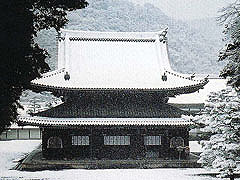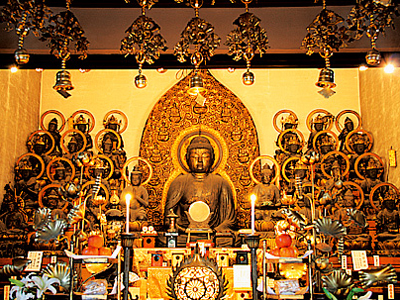
The ishirezakura, which is known for its early bloom, is a weeping cherry with a gentle branch. The temple is familiar with Benten-san on the island. It is famous for the earliest cherry blossoms in Kyoto, at the red-colored Tangkaze Gate, in the city of Kyoto and in the southern prefecture. A variety of cherry blossoms are blooming from around March 24 to around April 20.

The 84-year-old Kyo-pickled store is located at the intersection of Imakumano to the east. There are always 40 to 50 types, but the popularity is 100g 378 yen for pickled cucumber, eggplant, and alum, etc. with peri. 200g 1134 yen for the winter period.

Hengen, who conveys to the modern era the Fushimi doll, which is considered to be the source of the sandman form. It is humorous and features a simple expression. It can range from 3,600 yen for bawads, 2700 yen for tateofuku, etc., to hundreds of thousands of yen for zodiac dolls.

It is one of the Tōfuku-ji temples, and was founded in the first year of Mingde (1390). In the center of the garden of Kyusan-Hakkai, which was restored by Sanrei Shigemori, there is a bareback stone given by the Hosokawa family of the Kumamoto clan. It is said that this stone was taken into worship instead of declining the Five Hundred Stones of the Terashira. The garden of the other recumbent [gahm] is also beautiful. It also houses Russian prisoners of war during the Russo-Japanese War, and displays musical instruments they made of wood and bamboo. Note that it is not possible to see under the age of 12.

An ancient temple called Goji [Mitera], with a deep connection with the Imperial Family. There is a Buddhist temple (important cultural property) in the precinct where you can see the ceiling paintings of Kanō Yuyusaku. At the Kanyon-do near Daimon, the Tang Emperor Xuanzong (an important cultural treasure) is celebrated with the statue of Emperor Xuanzong (an important cultural treasure) that made him pray and build the Princess of Yang, and said that there are benefits for good quality, good-value, and beauty.

One of the Tofuku-ji towers. It was founded by Kanpaku Ichijo Uchikyo in order to mourn his father's bodhisattva during the Yuan Yen (1321-24), but it was diminished by fires and other events, resulting in the re-emergence of Ichijo Kaneki during the Gyeongan Year (1652-1705). It is also known as Sesifune-ji, due to the fact that there is a garden of Tsurukame, which is transmitted by the late Muromachi painter Sesshu Tōyō (Tōyō). In addition, it is reported that Ekan Ichijo, who was called "Cha-Kanpaku" during the Edo period, was entertained with tea at Tōfukuji Zunantei [and Odoi] during the Tofukuji Sanpo.

It stands in the precinct of Tōfuku-ji, known as the "Juman Immovable", and has a fire-repellent faith; and the statue of King Fudō in the Heian period of the Honson, which is enshrined in the Gotai-dō.

Attention to the stunning carvings; the completion of the Go-Hon-den and the four buildings of the Hai-den in Edo-Tenpo 11 (1840); the 8m carved dragon on the ceiling of the Hai-den, the 12 branches in the Hai-den, and the giraffe, the tenma, and the hima Tōrei-beu in the Tesuisha; the author is Shintaro Kyuyama.

It is located on the left hand side of Sengwaku-ji Temple. The Amitabha Buddha Twenty-Five Bodhisattva, which conveys the prayers of one thousand years to the present, is widely known as a Kyoraku autumn event reminiscent of the picture scrolls of the Pure Land in the modern era. The Twenty-Five Bodhisattva sitting statue, which is also designated as a national important cultural property along with the main temple of Amitabha, is Japan's only valuable cultural property as a three-dimensional sculpture of the Buddha, which is a collection of twenty-five bodhisattvas. In the small hall on the right side of the main hall, there is also a tomb that belongs to Yoichi Nasu, famous for the battle of Genpei.

It is the tower of Tofuku-ji and is known as the Temple of the Bumbu-ji. A brush offering is held on November 23 each year, in which the used-out writing tools in front of the brush mound are given thanks to the homaki.





